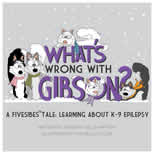Vestibular Disease
Written By: Dr Thomas DVM Dipl.ACVIM(Neurology)
The vestibular system senses the position of the head and body in space, in relation to gravity and movement. This helps the animal maintain balance and coordinate eye movements with movement of the head. The receptors for the vestibular system are located in the inner ear, adjacent to the hearing receptors. Vestibular information is processed in the lower portion of the brain in the brainstem and cerebellum. Therefore a problem in the inner ear or one in the brain can affect the vestibular system. The phrase "vestibular disease" is a general term referring to any abnormality of the vestibular system, although some people use this term to mean idiopathic vestibular disease (see below).
Clinical signs:
Signs of vestibular disease include ataxia, head tilt, and abnormal
nystagmus. A wide-based stance and swaying of the head and trunk
characterize ataxia. The patient may tend to lean and fall to
one side. In severe cases, the animal may continuously roll to
one side. Head tilt is an abnormal position of the head such that
one ear is held lower than the other. Nystagmus is a rhythmic
movement of the eyes, where the eyes move back and forth or up
and down. In some cases of vestibular disease, there is a sudden
onset of severe signs. This may initially be confused with a seizure.
Diagnosis:
Identification of vestibular dysfunction is based on recognition
of the specific signs. The veterinarian diagnoses the cause of
the disorder with a medical history and examination. In some cases,
further diagnostic tests, such as x-rays, computed tomography,
or magnetic resonance imaging is necessary.
Vestibular diseases:
Ear infection:
Infection of the middle/inner ear is a common cause of vestibular
disease in the dog. Most cases can be diagnosed by a thorough
examination of the ear with an otoscope. Ear culture, X-rays,
computed tomography or magnetic resonance imaging is sometimes
necessary. If bacteria cause the infection, treatment consists
of appropriate antibiotics.
Canine idiopathic
vestibular syndrome:
This is also
a common cause of vestibular disease in the dog. Another name
is geriatric vestibular syndrome. Older dogs (mean age 12.5 years)
are primarily affected. There is a sudden onset of ataxia (which
can be severe), head tilt, nystagmus and occasionally vomiting.
The cause of this syndrome is unknown. Diagnosis is based on the
signs and excluding other causes of vestibular dysfunction. Affected
dogs improve spontaneously within 2 weeks, although there may
be a mild, persistent head tilt. Nursing care is important during
recovery. Unfortunately, affected dogs are sometimes euthanized
because of the severe signs and concerns that the patient has
a brain tumor or stroke.
Hypothyroidism:
Hypothyroidism can cause vestibular dysfunction in dogs. Signs
may develop suddenly or over time. Diagnosis is based on laboratory
evaluation of thyroid function and response to thyroid supplementation.
Vestibular dysfunction typically resolves within 2 months of treatment.
Toxicity:
Medications placed in the ear are the most common cause of vestibular
toxicity; although some orally administered drugs can also be
a problem, especially at high doses. Ear drops or other substances
should never be placed in a dog's ear except on the specific recommendation
of a veterinarian.
Cancer:
Tumors in the inner ear or brain can cause vestibular problems.
Older animals are more commonly affected and there may be pain
on opening the mouth. Diagnosis is based on x-rays, CT, MRI, and/or
biopsy.
Encephalitis:
Inflammation of the brain (encephalitis) can cause vestibular
dysfunction. Causes include infections, such as distemper virus,
and non-infectious causes. Diagnosis often requires analysis of
spinal fluid. Some types of infection can be specifically treated
with medications.
WB Thomas DVM
Dipl.ACVIM(Neurology)
University of Tennessee
Knoxville, TN
Reference:
Thomas WB. Vestibular dysfunction. Vet Clin Small Anim Pract 30:227-249,
2000.
Links for Vestibular Disease
http://www.vetinfo.com/dencyclopedia/devestib.html
Page last update: 12/13/2011










